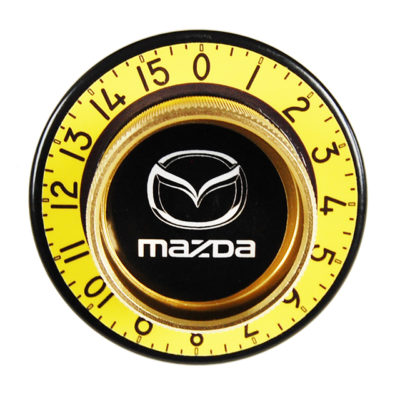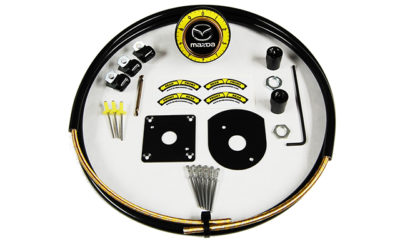(For all Parts Spotlights, click here)
Brake bias adjusters with a dial and detents make repeating your brake bias setting easy
If the rules for your class allow it, a brake bias adjuster can be a wonderful thing, especially during changing track conditions. The ability to change the front/rear bias on your brakes is critical when the race changes from dry to wet or vice-versa. To control that adjustment, Mazda Motorsports offers a pair of BrakeOMeter Brake Bias Adjusting Systems that offer some key advantages.
“We call it the knob with a brain,” says Glen Johnson of BrakeOMeter. “What it does is it alleviates the driver from the chore of trying to remember what they did with their brake bias. You have a knob and dial assembly – the dial has the numbers on it. Due to its dual detents, when you turn the knob, every quarter turn the knob is going to be set in place. This eliminates any self-adjusting. One complete rotation of the knob moves the dial one number, either way you turn it. With the BrakeOMeter, you know where you started, where you finished, how far you turned it and which way you turned it.”
The patented BrakeOMeter is designed to assist drivers with brake bias adjustment. It helps eliminate the driver from turning it too much or not enough – or, even worse, turning it the wrong way. “Normally, if you dial in too much rear brakes, the rear end comes around while trail braking; however, on most cars, more rear brakes is an advantage for racing in the rain,” Johnson notes.
 Another trick the BrakeOMeter has is that it’s very easy to set to zero once you have your brake bias dialed in for normal conditions. “You go out and run your session, you’ve adjusted your brake bias, but you want to start at zero again. You loosen the two set screws in the knob, pull it off, then pull the dial off, re-clock it back to zero and put it all back together,” Johnson says. That way, if you adjust the bias for unusual conditions, or as fuel and tires go off in a long stint, getting it back to where you started is a snap.
Another trick the BrakeOMeter has is that it’s very easy to set to zero once you have your brake bias dialed in for normal conditions. “You go out and run your session, you’ve adjusted your brake bias, but you want to start at zero again. You loosen the two set screws in the knob, pull it off, then pull the dial off, re-clock it back to zero and put it all back together,” Johnson says. That way, if you adjust the bias for unusual conditions, or as fuel and tires go off in a long stint, getting it back to where you started is a snap.
BrakeOMeter’s attention to detail doesn’t stop with the knob. The cable and housing get special treatment as well. “We use an aluminum extruded seamless tube that we Teflon coat on the inner diameter and ballistic nylon coat on the outer diameter. The reason we use an aluminum-extruded housing is it eliminates cable whip. At a minimum, you only need to mount the housing in two places. When you turn the knob, you’re ensured it turns the brake bias bar. We use a proprietary bi-axially wound cable, which means that you have one layer that goes to the left and the next layer goes to the right; goes to the left, goes to the right. The outer layer is a specifically designed material to work with Teflon, so you have permanent lubrication inside the cable housing. It’s [also] impervious to water and dirt,” explains Johnson.
Mazda is selling two versions of the BrakeOMeter systems, one for sedan-type cars such as GT and Production, and one for formula cars and sports racers. The A16 for sedans is three inches in diameter and has 16 numbers; from one end to the other is 16 turns. The F10, at 2.2 inches, is smaller for the tight confines of a formula car cockpit and takes only 10 turns to go from extreme to extreme.
A16
Part #: 0000-03-9103-16
Price: $224.95
F10
Part #: 0000-03-9103-10
Price: $224.95


 ACCESSIBILITY
ACCESSIBILITY